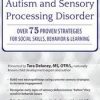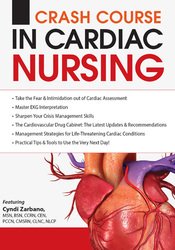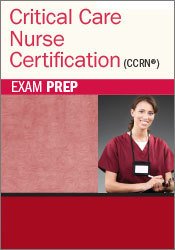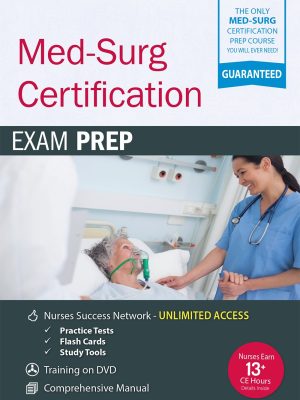Cyndi Zarbano – 2-Day Critical Care Skills Boot Camp
$439 Original price was: $439.$104Current price is: $104.
Shopping Instructions:
- DISCOUNT 15% : SHOP15
- Product Delivery: Within 1 – 12 hours after purchase.
Critically ill patients are everywhere these days – on the Med-Surg floor, in the ICU, the PACU, the ED, the OR, even long-term care! A good working knowledge of the concepts for managing high-acuity patients is indispensable.
Cyndi Zarbano – 2-Day Critical Care Skills Boot Camp
Get the Latest Clinical Information On:
- Crisis Management
- ABG Analysis
- Rhythm Interpretation in 5 Easy Steps
- Central Line Care
- Mechanical Ventilation
- And Much More!
DAY ONE: ESSENTIAL ASSESSMENT, INTERPRETATION AND INTERVENTION STRATEGIES
Critically ill patients are everywhere these days – on the Med-Surg floor, in the ICU, the PACU, the ED, the OR, even long-term care! A good working knowledge of the concepts for managing high-acuity patients is indispensable.
Join Cyndi Zarbano and learn the latest in essential critical care skills that you must know to be successful, including:
- Rapid Assessment
- ABG Analysis
- Central Line Care
- Easy Strip Interpretation
OUTLINE
Identification & Management of Crisis
- Master “down and dirty” prompt assessment skills
- End the “Red Flags”
- Rapid stabilizing interventions for the unstable patient
- Manage the decompensating patient
- Better outcomes through quick intervention
Easy Steps to ABG Analysis
- Acid base imbalance
- 4 abnormal findings when reading your lab result
- A simple tool to rapidly and efficiently interpret ABG’s!
The 5 Steps to Rhythm Strip Interpretation
- Systematically reviewing the major components of a rhythm strips
- Identifying rhythm changes and management of:
- Atrial Fibrillation and Atrial Flutter
- Paroxysmal Supra-Ventricular Tachycardia (PSVT)
- V-Tach and V-Fib
Managing Chest Drainage
- Indications for chest tubes
- Circumventing re-expansion pulmonary edema
- Avoiding common complications of chest drainage
Master Central Line Care
- Common issues experienced with central lines
- Using which port for what on a triple lumen PICC
- Use of a “cell-saver” to reduce lost hemoglobin during blood draws
- The challenge of CVP monitoring
Pacemakers & AICDs
- Indications for pacemakers
- Meaning of pacemaker codes
- Types of Pacemakers
- Device management
- Practical solutions to common pacemaker problems
End-of-Life Care in the ICU
- The needs of the patient
- Practical tips to help your patients and families with the end-of-life journey
OBJECTIVES
- Identify 5 essentials components of a “down and dirty” assessment in your patient when they have a sudden decomposition in health status.
- State 3 rapid interventions that can stabilize a patient who is symptomatic with a low blood pressure.
- Recognize the most common causes of arterial blood gas abnormalities.
- Quickly identify the 3 most common dysrhythmias using rhythm strip interpretation.
- Manage the risk to avoid re-expansion pulmonary edema in the patient with a chest tube for pleural effusion.
- Review the correct technique for opening an occluded central line lumen.
- Summarize the difference between failure to capture and failure to sense in a pacemaker and how each is resolved.
- Recognize the three biggest concerns patients recognize at end of life.
DAY TWO: ADVANCED MANAGEMENT OF COMPLEX AND CRITICALLY ILL PATIENTS
The Advanced Management of Complex and Critically Ill Patients seminar will give you a strong foundation, while integrating tips, timesavers, and stories about real nurses who make a difference in their patient’s lives. This seminar will teach you to master the concepts of critical care and become an expert in your clinical practice. Learn advanced critical care concepts and interventions, including:
- Advanced cardiac care/hemodynamics
- Advanced neurological care
- Mechanical ventilation management
OUTLINE
Understand Hemodynamics Today
- Cardiac Output = Heart Rate x Stroke Volume
- Use a simple analogy to learn the components and finally get it
- Preload, Afterload and Contractility
- Manipulating the mathematical equation to stabilize
The ICU Trio in Crisis!
- IV Fluids – picking the right one for the situation
- 5 pressor agents – How they work when to use them
- Blood products! FFP, Platelets, PRBC’s and Cryoprecipitate
Would you like to receive Cyndi Zarbano – 2-Day Critical Care Skills Boot Camp ?
Demystify Hemodynamic Waveforms and Correctly Measuring Each
- Assessment clues to hemodynamic instability
- Central Venous Pressures
- Arterial Lines
- Swan Ganz Catheters
Mechanical Ventilation for Nurses
- How to manage patients on ventilators
- Avoiding Ventilator Acquired Pneumonia (VAP)
- Using CPAP or BiPAP
Manage Shock
- Assessment and management of:
- Cardiogenic Shock
- Septic Shock
- Hypovolemic Shock
Manage the Neuro Patient
- Use a “5-point Neuro Check” to easily identify changes in condition
- Stroke and Stabilization
- Ischemic
- Hemorrhagic
- Delirium
- How to assess & intervene
Life-threatening EKG Changes: Clues from the 12-Lead
- Spectrum of coronary artery ischemia
- 5-step method for finding myocardial ischemia and injury
- STEMI and NSTEMI – What’s the difference?
- Location, location, location!
OBJECTIVES
- Summarize the difference between preload, contractility and afterload as components impacting cardiac output.
- Identify correct locations for measuring CVP, Arterial Line and Wedge waveforms.
- Differentiate between hypotonic, isotonic and hypertonic IV fluids and when each is considered most effective.
- Recognize the blood product of choice for Disseminated Intravascular Coagulopathy.
- Contrast the difference between hypovolemic shock, septic shock and cardiovascular shock in both assessment and treatment priorities.
- Identify two ways to increase the ventilator patient’s oxygenation status.
- Compare and contrast CPAP and BiPAP, as well as their target populations.
- State 5 common causes of delirium.
- Identify the difference between a STEMI and NSTEMI.
Here’s What You’ll Get in Cyndi Zarbano – 2-Day Critical Care Skills Boot Camp
Cyndi Zarbano – 2-Day Critical Care Skills Boot Camp : Sample
Related products
HEALTH & MEDICAL
HEALTH & MEDICAL
HEALTH & MEDICAL
HEALTH & MEDICAL
Cyndi Zarbano, Dr. Paul Langlois & Marcia Gamaly – Advanced Critical Care Nursing Conference
HEALTH & MEDICAL
Regina Meredith – Conscious Media Network with Regina Meredith – Eric Pearl on The Reconnection
HEALTH & MEDICAL
Dr Heidi M Crocker – Yoga Alignment | Speaker: Heidi Crocker EdD, DC
HEALTH & MEDICAL
Cyndi Zarbano – PCCN® Certification Exam Prep Package with Practice Test and NSN Access













